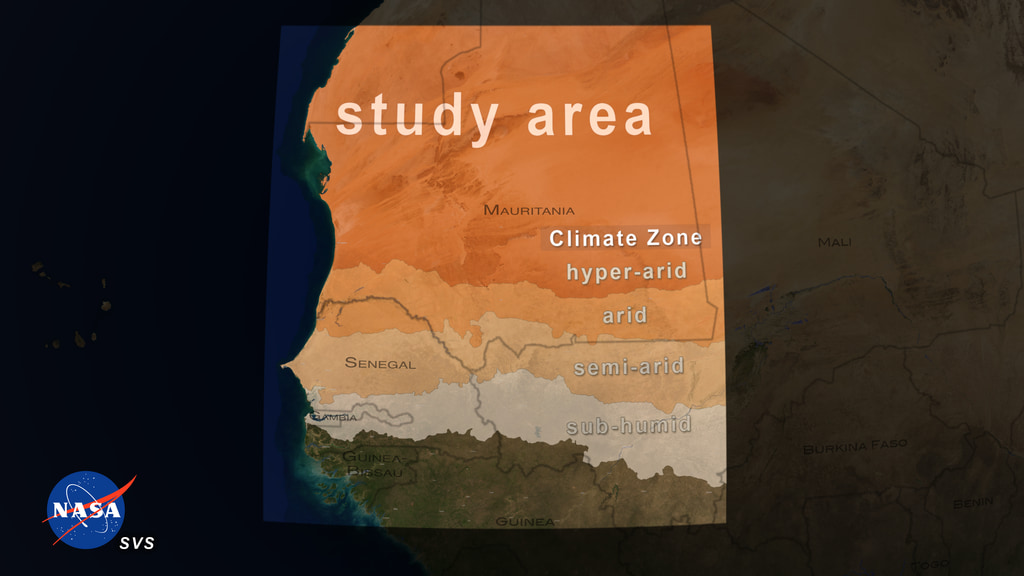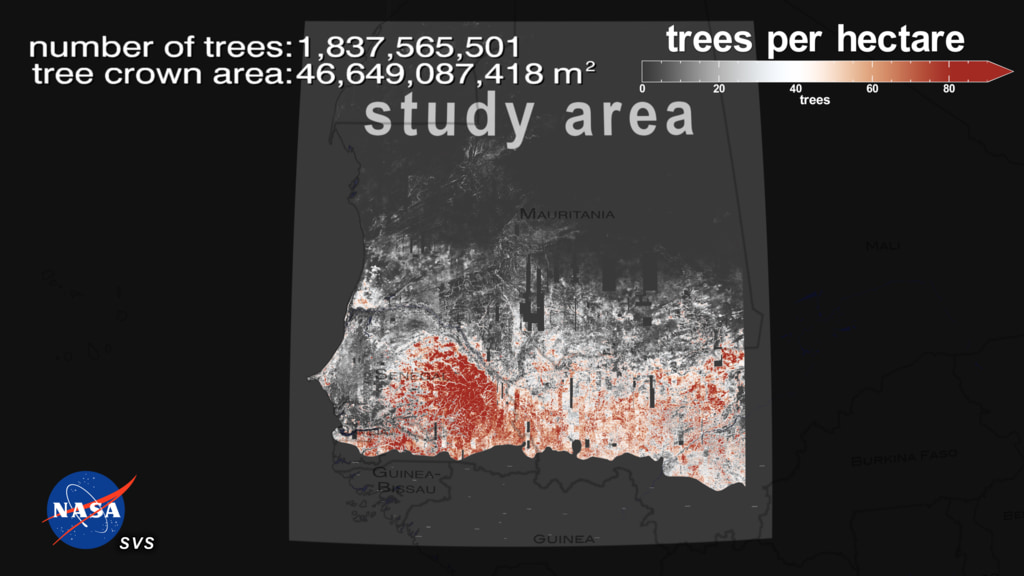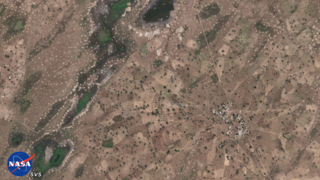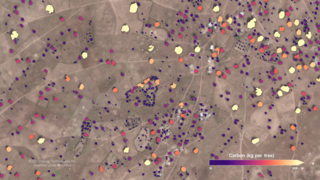Earth
ID: 4865
This visualization shows “an unexpectedly large count of trees in the West African Sahara and Sahel” which is also the title of the paper published in the 14-Oct-2020 issue of NATURE. Dryer areas of the globe that do not have forests are sometimes discounted for their contribution to the global biome in climate models and other prediction systems. However, this research has shown that over 1.8 billion trees are in the small study area in the West African Sahara and Sahel.
A deep learning algorithm was trained by the scientists to identify trees using very high resolution satellite imagery (0.5m per pixel) from DigitalGlobe. The algorithm identified trees by looking for appropriate colors and shadows cast. A total of 11,128 multispectral images were used to identify trees in this study region. Using this technique 1,837,565,501 trees were identified in the study region with a median tree crown area of 12 square meters.
The visualization starts at a global scale then pushes in to show the study area. To illustrate that this is a dry area, climate zones are shown using annual rainfall averages from 1982-2017 including regions that are:
The visualization next shows an area of high resolution imagery of the trees, then overlays the results of the machine learning which are filled regions of tree crowns for each tree in view. The trees are then counted up. The areas of trees are also totaled using the tree crown regions. We then zoom back out to see the entire study area and the total tree count and area.
This is a success story in using deep learning and big data to perform large scale scientific analysis. Now, scientists know the number and size of these trees in the Sahara and the Sahel. They will be able to use this information to calculate their impact to our planet.



An unexpectedly large count of trees in the West African Sahara and Sahel
A deep learning algorithm was trained by the scientists to identify trees using very high resolution satellite imagery (0.5m per pixel) from DigitalGlobe. The algorithm identified trees by looking for appropriate colors and shadows cast. A total of 11,128 multispectral images were used to identify trees in this study region. Using this technique 1,837,565,501 trees were identified in the study region with a median tree crown area of 12 square meters.
The visualization starts at a global scale then pushes in to show the study area. To illustrate that this is a dry area, climate zones are shown using annual rainfall averages from 1982-2017 including regions that are:
- hyper-arid (0-150 mm rainfall/year)
- arid (150-300 mm/year)
- semi-arid (300-600 mm/year)
- sub-humid (600-1000 mm/year)
The visualization next shows an area of high resolution imagery of the trees, then overlays the results of the machine learning which are filled regions of tree crowns for each tree in view. The trees are then counted up. The areas of trees are also totaled using the tree crown regions. We then zoom back out to see the entire study area and the total tree count and area.
This is a success story in using deep learning and big data to perform large scale scientific analysis. Now, scientists know the number and size of these trees in the Sahara and the Sahel. They will be able to use this information to calculate their impact to our planet.



Used Elsewhere In
Related
Visualization Credits
Greg Shirah (NASA/GSFC): Lead Visualizer
Compton Tucker (NASA/GSFC): Scientist
Martin Brandt (University of Copenhagen): Scientist
Jérôme Chave (French National Center for Scientific Research): Scientist
Erin Glennie (SSAI): Data Provider
Lori Perkins (NASA/GSFC): Visualizer
Helen-Nicole Kostis (USRA): Visualizer
Leann Johnson (Global Science and Technology, Inc.): Visualizer
Ian Jones (ADNET Systems, Inc.): Technical Support
Laurence Schuler (ADNET Systems, Inc.): Technical Support
Compton Tucker (NASA/GSFC): Scientist
Martin Brandt (University of Copenhagen): Scientist
Jérôme Chave (French National Center for Scientific Research): Scientist
Erin Glennie (SSAI): Data Provider
Lori Perkins (NASA/GSFC): Visualizer
Helen-Nicole Kostis (USRA): Visualizer
Leann Johnson (Global Science and Technology, Inc.): Visualizer
Ian Jones (ADNET Systems, Inc.): Technical Support
Laurence Schuler (ADNET Systems, Inc.): Technical Support
Please give credit for this item to:
NASA's Scientific Visualization Studio
NASA's Scientific Visualization Studio
Science Paper:
https://www.nature.com/articles/d41586-020-02830-3
Short URL to share this page:
https://svs.gsfc.nasa.gov/4865
Data Used:
Note: While we identify the data sets used in these visualizations, we do not store any further details nor the data sets themselves on our site.
Keywords:
DLESE >> Biology
SVS >> Biomass
DLESE >> Ecology
GCMD >> Earth Science >> Biosphere >> Ecological Dynamics >> Biomass
GCMD >> Earth Science >> Biosphere >> Vegetation >> Crown
SVS >> Hyperwall
NASA Science >> Earth
GCMD keywords can be found on the Internet with the following citation: Olsen, L.M., G. Major, K. Shein, J. Scialdone, S. Ritz, T. Stevens, M. Morahan, A. Aleman, R. Vogel, S. Leicester, H. Weir, M. Meaux, S. Grebas, C.Solomon, M. Holland, T. Northcutt, R. A. Restrepo, R. Bilodeau, 2013. NASA/Global Change Master Directory (GCMD) Earth Science Keywords. Version 8.0.0.0.0
https://www.nature.com/articles/d41586-020-02830-3
Short URL to share this page:
https://svs.gsfc.nasa.gov/4865
Data Used:
Terra and Aqua/MODIS/Blue Marble: Next Generation also referred to as: BMNG
Credit:
The Blue Marble data is courtesy of Reto Stockli (NASA/GSFC).
The Blue Marble data is courtesy of Reto Stockli (NASA/GSFC).
WorldView-2 © 2010 DigitalGlobe
Observed Data - DigitalGlobeLandsat-8/OLI/TIRS/Band Combination 4-3-2
Observed Data - USGSalso referred to as: OpenStreetMap
City lon/lat names and locations
Rasterized Tree Crowns (generated via ML from DigitalGlobe mosaics)
Analysis - NASAalso referred to as: Tree Locations (generated via ML from DigitalGlobe mosaics)
Analysis - NASAalso referred to as: Tree Densities (generated via ML from DigitalGlobe mosaics)
Analysis - NASAKeywords:
DLESE >> Biology
SVS >> Biomass
DLESE >> Ecology
GCMD >> Earth Science >> Biosphere >> Ecological Dynamics >> Biomass
GCMD >> Earth Science >> Biosphere >> Vegetation >> Crown
SVS >> Hyperwall
NASA Science >> Earth
GCMD keywords can be found on the Internet with the following citation: Olsen, L.M., G. Major, K. Shein, J. Scialdone, S. Ritz, T. Stevens, M. Morahan, A. Aleman, R. Vogel, S. Leicester, H. Weir, M. Meaux, S. Grebas, C.Solomon, M. Holland, T. Northcutt, R. A. Restrepo, R. Bilodeau, 2013. NASA/Global Change Master Directory (GCMD) Earth Science Keywords. Version 8.0.0.0.0













